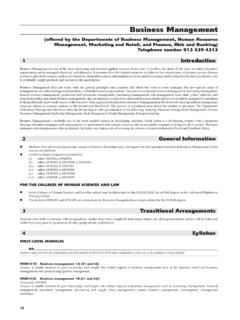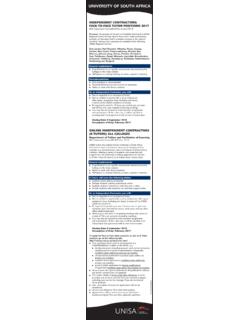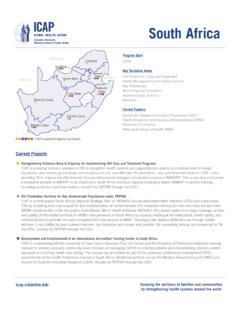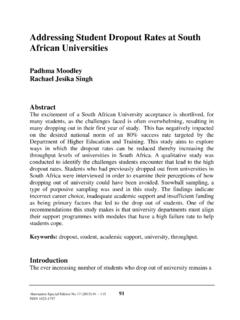Transcription of © 2010 University of South Africa - Lisa for Student …
1 2010 University of South AfricaAll rights reservedPrinted and published by theUniversity of South AfricaMuckleneuk, PretoriaPYC1501/1/2011 201298624660 InDesignWORKBOOK-Style iiiiii iii ContentsStudy programme vThe layout of a learning opportunity Learn how this course works Learn to represent information in graphic form Learn to chart a field of study Learn to prepare a presentation Learn to develop a psychological programme Learn to provide an expert opinion Explore the nature of impulse conduction in the human nervous system Explore the structure and functions of the human nervous system Explore the nature of different states of consciousness Explore the concepts of sensastion and perception Explore the concepts of thinking.
2 Reasoning and problem-solving Explore the concepts of intelligence and creativity Explore the concepts of learning and memory Explore the concept of emotion Explore the concept of personality 119 ivYou are here o vv v Study programmeStudy ProgrammeThe study programme for this module appears in the table below. The table lists the learning opportunities you have to execute, and also indicates the sequence in which you have to com -plete these learning opportunities. In addition, the table indicates how much time is required to complete a particular learning OpportunityTaskTime(hours) how this course works to represent information in graphic to chart a field of to prepare a to develop a psychological to provide an expert opinion55 Please note:Do the learning opportunities in the indicated sequence, that is from 1 to 6.
3 These learning opportunities are the main tasks you have to complete for this module. They are self-study units designed to help you develop basic skills and apply your knowledge of psychology. They are comprehensive and require a substantial amount of time to complete. The study schedule provided here serves merely as a guideline, because each Student works differently, according to his or her individual situation. These learning opportunities refer to other learning opportunities (in Study Guide) and to relevant resource material (in the resource text A Z)). The other learning opportunities are designed to help you explore relevant fields of information to increase your knowledge of psychology.
4 Please do not submit these learning opportunities as assignments for evaluation. Assign-ments and a trial examination paper (self-test) are provided separately. The assignments can be submitted for evaluation. The trial examination paper is for self-evaluation purposes and provides an indication of the kind of questions you can expect in the examination. You have to start with Learning Opportunity in this study layout of a learning opportunity viThe layout of a learning opportunityTitle of learning unitIdentifier of learningunitOutcome product of learningunitResource required for the first task in the methodFirst activity of the first task in themethodMethod toachieve theoutcome productFirst taskin the methodSEC-A-HCWPYC1501 11 1 SECTION ALearn how this course works opportunityLearn how this course worksOuTCOmE PrOduCTdescriptionEach learning opportunity has one or more outcomes.
5 The reason for studying this learning opportunity is to learn how this course works. In other words, through completing this learning opportunity you should gain knowledge of the design of this module as well as the instructional approach used in this module to teach psychology. StandardsThe outcome of a learning opportunity should adhere to particular standards. The outcome of this learning opportunity is your knowledge about the module s design and instructional ap -proach. Your knowledge about the module s design and instructional approach conforms to the required standards if your knowledge is relevant and criteriaYou have to use assessment criteria to determine whether you have achieved the required out -comes and whether your outcomes conform to the required standards.
6 Your knowledge of the module s design and instructional approach conforms to the required standards if you know enough (that is, if you have sufficient knowledge) about the module s design and instructional approach (that is, if your knowledge is relevant to the topic in question). Your knowledge is relevant and sufficient if:01 the nature of the components of the module is indicated 02 the nature of learning opportunities is indicated03 the nature of the learning process that is required in this module is indicated. 33 3 Learn how this course worksmETHOdTasksYou have to use a method to produce the outcomes required by the learning opportunity.
7 The method consists of one or more tasks. This learning opportunity has three tasks, namely to: indicate the nature of the module components indicate the nature of a learning opportunity indicate the nature of the module learning outcomesThe outcomes of the learning opportunity are broken down into more specific task outcomes. The task outcomes are achieved by carrying out appropriate resourcesEach task lists the resources required for the task s are able to indicate the components of the module if you:01 recognise the various module components02 recognise the nature of each component03 recognise the links between 1 Note the following abbreviations:SG for study guideLO for learning opportunityA Z for the prescribed resource text1.
8 Read Tutorial Letter 101: Module componentsActivity 2 Make a list of the various module down your own answer before you look at the answer given Administrative component, consisting of:TL 101 Indicate the nature of the module componentsResourceFrom Tutorial Letter 101: Module componentsLearn how this course works 42. Assessment component, consisting of:TL 102 and TL 2013. Instructional component, consisting of:Section A of the study guideSection B of the study guideA Z (resource text)Activity 3 Match the tutorial letter number with the proper description. Here are the descriptions:(a) This tutorial letter informs learners about administrative processes and procedures regard-ing their studies(b) This tutorial letter contains learning opportunities(c) This tutorial letter contains examples of examination questions(d) This tutorial letter helps learners to develop skills in applying psychological knowledge(e) This tutorial letter tells learners how to contact the University (f) This tutorial letter provides feedback on assignment questions(g) This tutorial letter contains methods for exploring topics in psychologyHere are the tutorial letter numbers:1.
9 TL 101 2. TL 1023. TL 2014. Study Guide Section A5. Study Guide Section BAnswer1. TL 101: a, e2. TL 102: c3. TL 201: f4. SG: Section A b, d5. SG: Section B b, gActivity 4In A Z, find the resource with the title Information modelling: expandable tree structure .AnswerThe different sections in A Z are identified by their unique titles. Locating the resource is not dif -ficult because the titles are arranged in alphabetical order according to the first word in the title. The resource with the title of Information modelling: expandable tree structure can therefore be found by looking for titles beginning with I. 55 5 Learn how this course works02 You are able to indicate the nature of learning opportunities if you:01 recognise the various components of a learning opportunity02 recognise the nature of the components of a learning 1 Read TL101: Module learning 2 List the various components of a learning 3 What is the unique identifier of the learning opportunity that you are currently using?
10 How would you refer to this learning opportunity?AnswerUnique identifier is: reference is: LO 4 What is the outcome product of the learning opportunity that you are currently executing?AnswerRelevant and comprehensive knowledge of the design and instructional approach of the 5 How would you know that your knowledge of the design and instructional approach of the mod -ule is comprehensive and relevant? Answer1. the nature of the module components is indicated 2. the nature of learning opportunities is indicated3. the nature of the learning process in the module is the nature of learning opportunitiesResourceFrom Tutorial Letter 101: Module learning opportunityLearn how this course works 6 Activity 6 Describe the method for producing the outcome product of this method consists of three tasks, namely Task 1: Indicate the nature of the module componentsTask 2: Indicate the nature of learning opportunitiesTask 3: Indicate the nature of the module learning task has particular task outcomes, namely the ability to:Task 1: 1.










